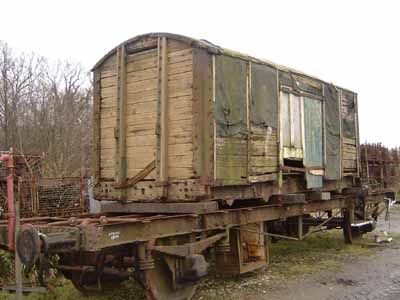 1590 was our second LBSCR Goods van, which, following an intial contact from Mike Cruttenden, chairman of the Brighton Circle, and
courtesy of cooperation from Goring Hardware and the owners of the site, arrived on the Bluebell Railway from its previous resting
place at Jenkins Yard in Ferring, on 25 January 2005. The first, very similar LBSCR Box Van, had
arrived in 1981, and its restoration had finally been completed in 2004.
1590 was our second LBSCR Goods van, which, following an intial contact from Mike Cruttenden, chairman of the Brighton Circle, and
courtesy of cooperation from Goring Hardware and the owners of the site, arrived on the Bluebell Railway from its previous resting
place at Jenkins Yard in Ferring, on 25 January 2005. The first, very similar LBSCR Box Van, had
arrived in 1981, and its restoration had finally been completed in 2004.
Because preserved Brighton goods vehicles are very rare, even though this vehicle was in poor condition, it was felt worthy of
preservation. Although a lot is missing, and little of the timber work would be savageable, it has a lot of iron fittings present,
including door furniture, structural ironwork and lamp irons, which mean that eventual restoration would be feasible. It also
provides an interesting comparison with our restored example, which is slightly newer, and has detailed
differences. In particular, No.1590 has external "J" iron straps either side of the door, in addition to the massive interior knee.
The van was built in the second half of 1908, to replace an older Stroudley van. It was later numbered 46263, in Southern Railway
days. It was withdrawn from service on the SR on 2nd February 1946; it has not yet been established whether it was sold out of
service immediately and went straight to Ferring, or whether it saw other use elsewhere first.
In September 2008 we were able to obtain (from Preston Park, seen in Trevor Stone's photo on the right) an LBSCR van underframe with
grease axleboxes painted with the number 1577. This had doubtless previously seen service at a MoD establishment, probably RNAD
Bedenham, where it had been converted to a flat wagon with ends suitable for carrying palletised materials. There is no evidence of
the original identity of the underframe and the number 1577 should be regarded as misleading.
Regrettably, the timberwork of the body of 1590 was completely destroyed in an accidental fire at Horsted Keynes in the early hours
of 16 July 2010. The fire appears to have been caused by sparks whipped up by extremely strong winds, from the embers of a bonfire
which had been burning 20-30 feet away a day or two earlier. Given that the timberwork would have been replaced as part of its
restoration, it still seems entirely feasible to reconstruct it using the salvaged metalwork on the "1577" underframe, as had in any
case been planned.










